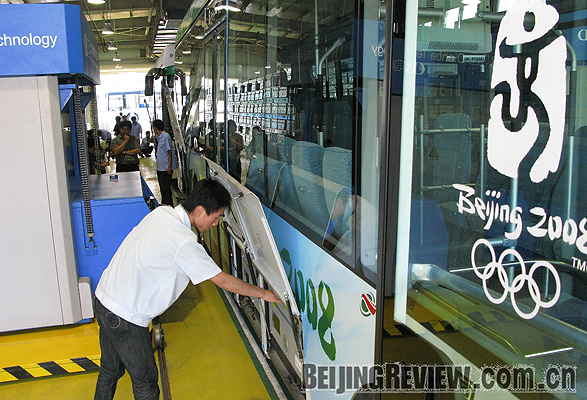|

EMISSION-FREE BUSES: A worker changes the battery for a lithium battery powered bus in the Olympic Village on July 6. Fifty such buses will operate around the clock during the Olympics
Beijing has fulfilled most of its environmental commitments for the 2008 Olympics with a larger-than-expected investment, according to a recent Greenpeace report.
The international environmental watchdog released the report, entitled "China After the Olympics: Lessons From Beijing," in Beijing on July 28, less than two weeks before the Olympics. It is its third assessment report of the environmental performances of Olympic Games host cities after Sydney and Athens.
"Beijing has achieved most, if not all, of the environmental commitments it made when bidding for the Games," said Lo Sze Ping, Greenpeace China's Campaign Director. "In certain aspects, Beijing has achieved more than what it committed to do, in terms of actual money spent and green coverage of the city."
The report highlights both Beijing's environmental achievements and the opportunities the city has missed in using the Olympics to carry out more ambitious environmental initiatives.
Beijing has introduced state-of-the-art energy-saving technologies-such as solar hot water and geothermal and solar photovoltaic systems-in its Olympic venues, the report says. Twenty percent of the electricity used in Olympic venues during the Olympics will come from clean wind sources.
More than 3,700 buses will run on compressed natural gas at the time of the Olympics-one of the largest fleets of this kind operating in any city in the world, the report says.
The city has added four new rail lines including a direct line to the Olympic Green to encourage public transportation, the report says. Beijing has also revised its vehicle emissions standards to match EURO IV, one of the most stringent emission standards in the world.
By the end of 2007, Beijing had upgraded 16,000 boilers under 20 tons and 44,000 boilers under 1 ton, according to the report. It had converted 32,000 household heating systems from coal heating to electricity by the same time.
| 